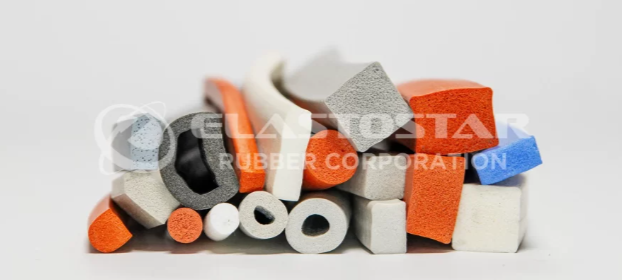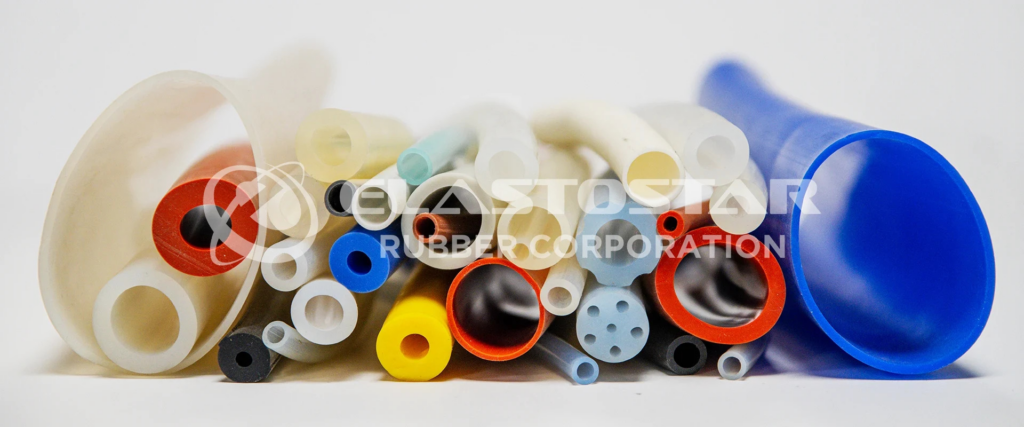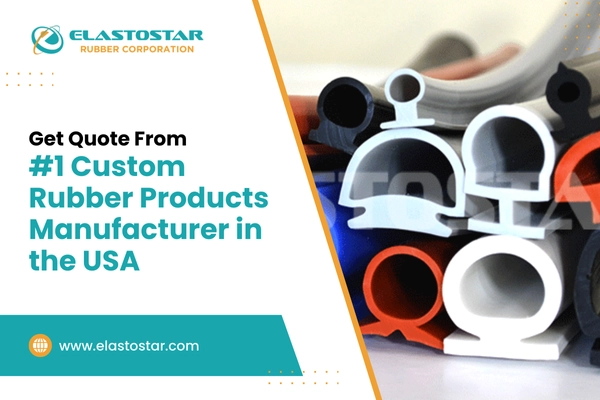When it comes to high-performance materials, fluorosilicone rubber and silicone rubber often top the list, but they’re not interchangeable. Each offers unique strengths, from temperature resistance to chemical compatibility, and is ideal for different industries’ applications and environments.
Whether sealing components in a jet engine or insulating electronics in extreme weather, choosing the right elastomer can make all the difference.
In this blog, we’ll break down the key differences between fluorosilicone and silicone rubber, explore where each material thrives, and help you decide which suits your application best.
What is Fluorosilicone?

Fluorosilicone rubber (FVMQ) is a durable elastomer that combines the flexibility of silicone with enhanced chemical resistance. Thanks to its fluorinated side chains, it performs exceptionally well in environments exposed to fuels, oils, and solvents.
This material maintains stability across a wide temperature range, typically from –60°C to 200°C, for demanding conditions in the aerospace, automotive, and chemical processing industries.
Its resilience against compression and environmental exposure ensures long-lasting performance in mission-critical sealing applications.
Important Attributes of Fluorosilicone Rubber
| Property | Performance |
| Operating Temperature | -60°C to 200°C |
| Fuel & Solvent Resistance | Excellent |
| Flexibility | Moderate to High |
| UV & Weather Resistance | Reliable |
| Common Use Cases | Aerospace seals, fuel system O-rings, valves |
| FDA Grade Availability | Limited |
| Compression Set | Low – maintains shape over time |
What is Silicone?

Silicone rubber seals are a highly flexible synthetic elastomer known for its exceptional thermal stability, biocompatibility, and resistance to moisture and chemicals. With a typical temperature range of -60°C to 230°C, they maintain their performance across extreme environments, hot or cold. One of their biggest strengths lies in their versatility.
Sponge rubber seals are used in nearly every industry, from medical tubing to automotive gaskets and electronic insulation. Depending on application needs, manufacturers can choose from various types, such as high-consistency rubber (HCR), liquid silicone rubber (LSR), and RTV (room-temperature vulcanizing) grades.
Its clean finish, low toxicity, and stability under mechanical stress make it a preferred material in consumer and industrial-grade products.
Read More – Silicone Rubber: How long does it last?
What are the Common Types of Silicone Rubber?
| Type | Feature of silicone | Typical Applications |
| HCR (High-Consistency) | Durable, moldable, great mechanical strength | Gaskets, seals, insulation |
| LSR (Liquid Silicone) | Flowable, suitable for injection molding | Medical components, complex geometries |
| RTV (Room-Temp Vulcanizing) | Cures at room temp, easy to apply | Adhesives, coatings, sealing compounds |
| FDA-Grade Silicone | Food-safe, non-toxic | Food & beverage, medical-grade tubing |
Major Differences Between Fluorosilicone and Silicone
Though both are silicone-based elastomers, rubber rings and silicone differ significantly in performance and ideal applications. The primary difference lies in chemical structure. O-rings include fluorine atoms resistant to fuels, solvents, and oils. At the same time, standard silicone is more widely used for its broad temperature tolerance, softness, and flexibility.
While silicone excels in general-purpose sealing, o-ring sealants are preferred in aggressive environments like fuel systems and chemical plants. Silicone, on the other hand, is more cost-effective and suitable for medical, food-grade, and HVAC applications.
Fluorosilicone vs. Silicone- Performance Comparison
| Property | Silicone Rubber | Fluorosilicone Rubber |
| Chemical Resistance | Moderate (not ideal for fuels/solvents) | Excellent (resists fuels, oils, solvents) |
| Temperature Range | -60°C to 230°C | -60°C to 200°C |
| Flexibility | Very High | Moderate to High |
| Compression Set | Low – good recovery | Low – excellent recovery |
| Cost | More economical | Higher due to excellent performance |
| FDA Compliance | Common | Limited |
| Common Industries | Medical, food, lighting, electronics | Aerospace, automotive, chemical processing |
Which Material Is Better for Your Application?

If your application demands high chemical resistance, such as exposure to fuels, oils, or solvents, fluorosilicone rubber is the better choice. It’s ideal for aerospace, chemical, and automotive environments.
On the other hand, silicone rubber is preferred for general-purpose sealing where flexibility, temperature stability, and FDA compliance matter, such as in custom silicone gaskets, food-grade tubing, and medical components.
Choosing between the two depends on the material properties needed for your specific use case: chemical durability or versatile sealing performance.
Recommended Applications for Fluorosilicone and Silicone
Both O-rings and silicone gaskets serve critical roles across industries, but their ideal use cases differ based on chemical exposure and flexibility needs.
Fluorosilicone Rubber Applications
- Aerospace: Seals and Silicone O-rings exposed to jet fuels and hydraulic fluids
- Automotive: Fuel system gaskets, turbocharger seals, and engine bay components
- Chemical Processing: Equipment parts requiring resistance to solvents and aggressive fluids
- Military & Defense: High-performance seals for mission-critical environments
Silicone Rubber Applications
- Medical Devices: Tubing, gaskets, and components that require biocompatibility
- Food & Beverage Industry: FDA-compliant seals for food processing and packaging equipment
- Electronics: Insulating components and weatherproof gaskets
- HVAC Systems: Rubber seals and gaskets for ducting and temperature regulation
As a trusted silicone rubber gasket manufacturer, Elastostar offers custom silicone gaskets, seals, and fluorosilicone parts customised to meet the demands of these industries.
Fluorosilicone vs Silicone: Which One Should You Choose?
The decision to select between silicone sponge rubber and O-ring seal depends on your application’s environmental exposure, operating temperature, and chemical interaction.
Choose Fluorosilicone when
- The application involves exposure to fuels, oils, and aggressive solvents
- Consistent performance is required within a fluorosilicone temperature range of -60°C to 200°C
- Long-term chemical durability is more critical than flexibility
- Common in aerospace applications, automotive fuel systems, and chemical equipment
Choose Silicone when
- You need high flexibility, excellent thermal resistance, and broad usability
- The environment requires FDA-grade, biocompatible, or food-safe materials
- Cost-effectiveness and material softness are key factors
- Ideal for medical devices, food processing, HVAC, and lighting components
As trusted rubber seal manufacturers, Elastostar helps industries choose the right compound based on performance goals, durability, and compliance.
Elastostar’s Expertise in Fluorosilicone and Silicone Products
At Elastostar, we specialize in precision-engineered silicone and fluorosilicone solutions customised for high-performance industrial needs. As trusted silicone rubber extrusion manufacturers, we deliver custom profiles, seals, and gaskets that meet strict technical and regulatory standards.
Our strengths include
- Durable custom silicone rings, O-rings, and fluorosilicone seals for critical applications
- In-house reverse engineering, from prototype to production run
- Full design help and material consultation for complex projects
- Shortest lead time delivery in the industry
- Expertise in FDA-compliant, aerospace-grade, pharmaceuticals and chemical-resistant formulations
Elastostar is your go-to partner for tailored silicone and fluorosilicone components, whether you need flexibility, fuel resistance, or precision sealing.
Recommended Reads
- Top Benefits of Using Silicone Rubber in the Aerospace Industry
- Guide: FDA-Approved Silicone Rubber Profiles
- Silicone Rubber vs. Neoprene – What to Choose?
Conclusion
Understanding the differences between silicone and fluorosilicon is critical for choosing the right material for your sealing, insulating, or gasketing needs. While fluorosilicon offers exceptional chemical resistance, silicone provides unmatched flexibility, temperature stability, and broader industry use.
Whether you need custom rubber gaskets, fuel-resistant seals, or advanced silicone rubber compounding, Elastostar delivers precision solutions that meet your specific application requirements.
Explore our complete range of silicone and fluorosilicone products designed for industrial performance. Contact us today to speak with our experts or request a custom quote.
FAQs
Is fluorosilicone the same as silicone?
No, fluorosilicone is not the same as silicone. While both are silicone-based elastomers, fluorosilicone includes fluorine, giving it greater resistance to fuels and chemicals — ideal for aerospace and automotive use.
What are the advantages of fluorosilicone?
Fluorosilicone provides excellent fuel and oil resistance and flexibility across a wide temperature range. For durable sealing in critical environments, Elastostar offers fluorosilicone O-rings and gaskets. Contact us for options.
What is the temperature range for fluorosilicone rubber?
Fluorosilicone performs reliably from -60°C to 200°C, making it suitable for extreme cold and fuel system applications.
What is the difference between silicone and silica?
Silicone is a flexible rubber used in seals and tubing, while silica is a reinforcing filler added to improve silicone’s strength and durability.
Is fluorosilicone safe for food contact?
No, fluorosilicone is not suitable for food-grade use. For hygienic sealing, Elastostar recommends FDA-approved rubber tubing or gaskets built for food processing.
Which silicone is better for industrial sealing?
Silicone works best for flexible, general-purpose sealing. Fluorosilicone is preferred in environments with harsh chemicals. For tailored solutions, Elastostar supports industrial sealing with custom rubber profiles.


